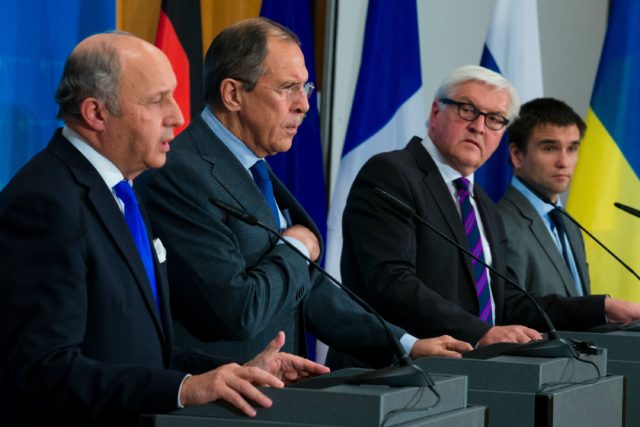
Steinmeier’s Formula: Its Background and Development in the Normandy and Minsk Processes (Part One)
Publication: Eurasia Daily Monitor Volume: 16 Issue: 130
By:

Moscow exploits the new Ukrainian leadership’s inexperience as a chance to cement Russian control over Ukraine’s Donetsk and Luhansk territories in a political settlement. President Volodymyr Zelenskyy looks eager for a quick-fix “peace” as a goal in itself, and he hopes for a meeting and dialogue with Russian President Vladimir Putin. By the same token, the Kremlin is exploiting a growing Western European mood (led by French President Emmanuel Macron) to “normalize” relations with Russia, at Ukraine’s expense if necessary. All this emboldens Moscow to harden its own terms for “peace” in Ukraine’s east and to raise its preconditions to holding either a Putin-Zelenskyy meeting or a “Normandy Group” (Russia, Germany, France, Ukraine) summit (see EDM, September 17).
Russia now demands Ukraine’s and the Normandy Group’s written codification of “The Steinmeier Formula” as a key precondition to summitry and a political settlement. Authored in 2015–2016 by Germany’s then–minister of foreign affairs, Frank-Walter Steinmeier (head of state since 2017), this concept is designed to implement the political clauses of the Minsk “accords” (2014 and 2015) in line with Russia’s interpretation but against Ukraine’s national interests. The “Formula” enjoys official support in Berlin and Paris, as well as Russia’s eager embrace. However, the Formula’s application would necessitate Ukraine’s consent as the recognized holder of sovereignty over the territory of Russian-occupied Donbas. As such, Ukraine has successfully resisted the pressures from Russia, Germany and France to codify Steinmeier’s Formula in the Normandy and Minsk negotiation processes thus far. In Washington, the Donald Trump administration has reversed the previous administration’s go-along attitude toward this Formula (see below).
Steinmeier’s Formula serves to legitimize Russia’s proxies in the Donetsk and Luhansk “people’s republics” (DPR, LPR) by means of staging local elections there. As such, it represents one of the decisive phases in a process to consecrate Russia’s de factocontrol of that territory, even if the territory is then reinserted nominally into Ukraine (see EDM, September 17).
Narrowly construed, Steinmeier’s Formula embodies a series of steps to stage and validate those local “elections,” so as to “democratically” qualify the Russian-controlled territory for a “special status” under Ukraine’s constitution. More broadly construed, the Formula clearly implies staging those local “elections” even as the two “people’s republics,” along with their Russia-led military organizations, remain in place, and with Russia controlling both sides of the Ukraine-Russia border in that territory. Steinmeier’s Formula is in agreement with Russia’s literal interpretation of the Minsk “agreements”—namely, that the withdrawal of “foreign” or “unlawful” forces and the restoration of Ukrainian control on the Ukrainian side of that border are matters to be negotiated only after those elections would have been staged locally and validated internationally.
The core of Steinmeier’s Formula is a pretense that it is possible to hold democratically valid elections in the circumstances of Russian military control of that territory and under Russian-installed local administrations (the “DPR-LPR”). That pretense is not only a political cover for a solution on Moscow’s terms but also a cultural pretense in a certain sense. That territory never saw democratically valid elections after the Soviet era. It remained a stronghold of the unreformed Communist Party for more than a decade and was then a reliable base of Ukraine’s Party of Regions for another decade. It produced obedient, 70 percent majorities for those parties, one after the other, for more than two decades until 2014, at which point Russia and its proxies took over.
Holding democratically valid elections in this territory under Russian control is therefore unthinkable. This is also the US State Department’s position, as Special Representative Kurt Volker has repeatedly articulated it. A secure environment would have to be established before implementing the political and technical procedures for holding elections. As minimal preconditions to a secure environment, the Russian military must withdraw from the territory, the “DPR-LPR” forces must be dissolved, and the Ukrainian side of the border has to be brought under non-Russian control, according to Volker’s most recent comments on Steinmeier’s Formula (Ukraiynska Pravda, Interfax-Ukraine, September 14, 15).
No document has ever been agreed upon to codify the Steinmeier Formula in the Normandy or Minsk negotiations. The twin causes (see above) are Ukraine’s resistance and the broader implications of the Steinmeier Formula. Those implications, in turn, have invited continuing accretions to the Formula during four years of negotiations in the Normandy and Minsk processes. And those processes have generated an abundant record of negotiations over the Steinmeier Formula from 2015 to date, much of it available in the public domain.
On October 2, 2015, in the Normandy Four leaders’ summit in Paris, Steinmeier presented the primordial version of what would become his Formula to implement the Minsk “agreements’ ” political clauses. It envisaged the known sequence of steps, whereby the Ukrainian parliament would adopt: 1) a constitutional law on the special status of the Donetsk-Luhansk territory; 2) an amnesty law regarding liability for “the events” in that territory (thus enabling those involved in “the events” to hold offices in that territory); and 3) a special law on holding elections in that territory. In the next steps, within 90 days of the special electoral law taking effect, elections in that territory would be held; the Ukrainian parliament would bring the law on the special status into effect, provisionally, in the evening of the day when the elections are held; and the parliament would bring that special status law into effect on a permanent basis as soon as the Organization for Security and Cooperation in Europe’s (OSCE) election-monitoring Office of Democratic Institutions and Human Rights certifies that those elections complied with the OSCE’s election standards.



